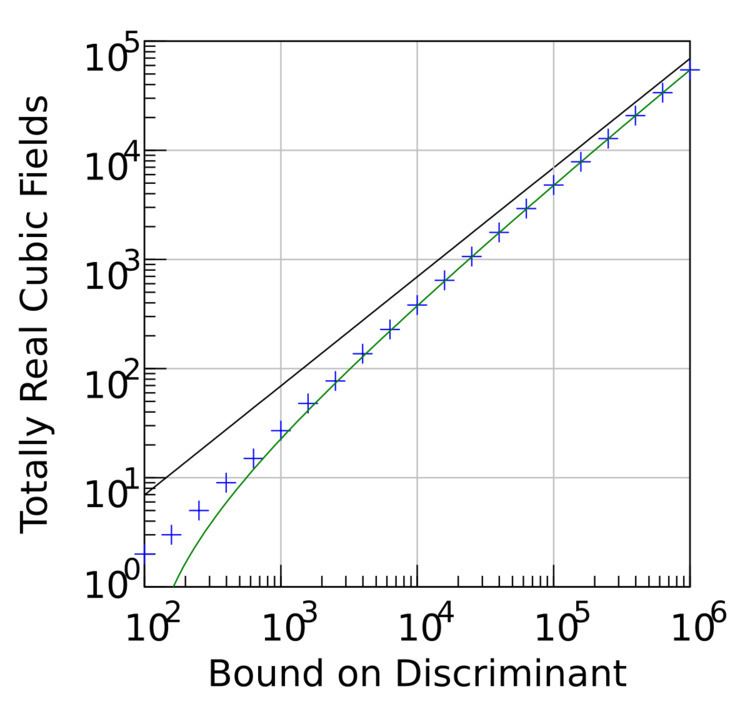 | ||
In mathematics, specifically the area of algebraic number theory, a cubic field is an algebraic number field of degree three.
Contents
Definition
If K is a field extension of the rational numbers Q of degree [K:Q] = 3, then K is called a cubic field. Any such field is isomorphic to a field of the form
where f is an irreducible cubic polynomial with coefficients in Q. If f has three real roots, then K is called a totally real cubic field and it is an example of a totally real field. If, on the other hand, f has a non-real root, then K is called a complex cubic field.
A cubic field K is called a cyclic cubic field, if it contains all three roots of its generating polynomial f. Equivalently, K is a cyclic cubic field if it is a Galois extension of Q, in which case its Galois group over Q is cyclic of order three. This can only happen if K is totally real. It is a rare occurrence in the sense that if the set of cubic fields is ordered by discriminant, then the proportion of cubic fields which are cyclic approaches zero as the bound on the discriminant approaches infinity.
A cubic field is called a pure cubic field, if it can be obtained by adjoining the real cube root
Examples
Galois closure
A cyclic cubic field K is its own Galois closure with Galois group Gal(K/Q) isomorphic to the cyclic group of order three. However, any other cubic field K is a non-galois extension of Q and has a field extension N of degree two as its Galois closure. The Galois group Gal(N/Q) is isomorphic to the symmetric group S3 on three letters.
Associated quadratic field
The discriminant of a cubic field K can be written uniquely as df2 where d is a fundamental discriminant. Then, K is cyclic if, and only if, d = 1, in which case the only subfield of K is Q itself. If d ≠ 1, then the Galois closure N of K contains a unique quadratic field k whose discriminant is d (in the case d = 1, the subfield Q is sometimes considered as the "degenerate" quadratic field of discriminant 1). The conductor of N over k is f, and f2 is the relative discriminant of N over K. The discriminant of N is d3f4.
The field K is a pure cubic field if, and only if, d = −3. This is the case for which the quadratic field contained in the Galois closure of K is the cyclotomic field of cube roots of unity.
Discriminant
Since the sign of the discriminant of a number field K is (−1)r2, where r2 is the number of conjugate pairs of complex embeddings of K into C, the discriminant of a cubic field will be positive precisely when the field is totally real, and negative if it is a complex cubic field.
Given some real number N > 0 there are only finitely many cubic fields K whose discriminant DK satisfies |DK| ≤ N. Formulae are known which calculate the prime decomposition of DK, and so it can be explicitly calculated.
However, it should be pointed out that, different from quadratic fields, several non-isomorphic cubic fields K1, ..., Km may share the same discriminant D. The number m of these fields is called the multiplicity of the discriminant D. Some small examples are m = 2 for D = −1836, 3969, m = 3 for D = −1228, 22356, m = 4 for D = −3299, 32009, and m = 6 for D = −70956, 3054132.
Any cubic field K will be of the form K = Q(θ) for some number θ that is a root of the irreducible polynomial
with a and b both being integers. The discriminant of f is Δ = 4a3 − 27b2. Denoting the discriminant of K by D, the index i(θ) of θ is then defined by Δ = i(θ)2D.
In the case of a non-cyclic cubic field K this index formula can be combined with the conductor formula D = f2d to obtain a decomposition of the polynomial discriminant Δ = i(θ)2f2d into the square of the product i(θ)f and the discriminant d of the quadratic field k associated with the cubic field K, where d is squarefree up to a possible factor 22 or 23. Georgy Voronoy gave a method for separating i(θ) and f in the square part of Δ.
The study of the number of cubic fields whose discriminant is less than a given bound is a current area of research. Let N+(X) (respectively N−(X)) denote the number of totally real (respectively complex) cubic fields whose discriminant is bounded by X in absolute value. In the early 1970s, Harold Davenport and Hans Heilbronn determined the first term of the asymptotic behaviour of N±(X) (i.e. as X goes to infinity). By means of an analysis of the residue of the Shintani zeta function, combined with a study of the tables of cubic fields compiled by Karim Belabas (Belabas 1997) and some heuristics, David P. Roberts conjectured a more precise asymptotic formula:
where A± = 1 or 3, B± = 1 or
Unit group
According to Dirichlet's unit theorem, the torsionfree unit rank r of an algebraic number field K with r1 real embeddings and r2 pairs of conjugate complex embeddings is determined by the formula r = r1 + r2 − 1. Hence a totally real cubic field K with r1 = 3, r2 = 0 has two independent units ε1, ε2 and a complex cubic field K with r1 = r2 = 1 has a single fundamental unit ε1. These fundamental systems of units can be calculated by means of generalized continued fraction algorithms by Voronoi, which have been interpreted geometrically by Delone and Faddeev.
